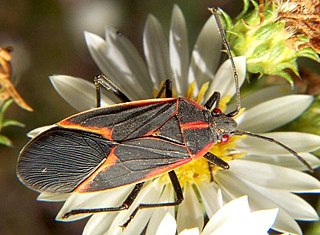
The boxelder bug, also called box bug, maple bug or, inaccurately, box beetle, is a North American species of true bug. It is found primarily on boxelder trees, as well as maple and ash trees. The adults are about 13 millimetres (0.51 in) long with a dark brown or black coloration, relieved by red wing veins and markings on the abdomen; nymphs are bright red. In 2020, this species invaded Chile, thus becoming an invasive species.

The map is a butterfly of the family Nymphalidae.
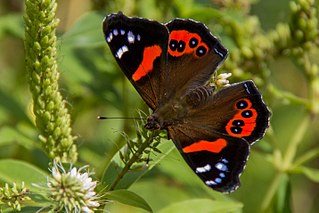
The New Zealand red admiral is a butterfly endemic to New Zealand. Its Māori name is kahukura, which means "red cloak". The red admiral is a member of the family Nymphalidae, the subfamily Nymphalinae and the tribe Nymphalini. There are two subspecies: V. g. gonerilla, which occurs on the mainland of New Zealand, and V. g. ida, which occurs on the Chatham Islands.
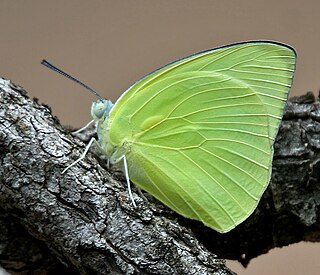
Catopsilia pomona, the common emigrant or lemon emigrant, is a medium-sized pierid butterfly found in Asia, Cambodia and parts of Australia. The species gets its name from its habit of migration. Some early authors considered them as two distinct species Catopsilia crocale and Catopsilia pomona.

The Lygaeidae are a family in the Hemiptera, with more than 110 genera in four subfamilies. The family is commonly referred to as seed bugs, and less commonly, milkweed bugs, or ground bugs. However, while many of the species feed on seeds, some feed on sap (mucivory) or seed pods, others are omnivores and a few, such as the wekiu bug, are carnivores that feed exclusively on insects. Insects in this family are distributed across the world. The family was vastly larger, but numerous former subfamilies have been removed and given independent family status, including the Artheneidae, Blissidae, Cryptorhamphidae, Cymidae, Geocoridae, Heterogastridae, Ninidae, Oxycarenidae and Rhyparochromidae, which together constituted well over half of the former family.
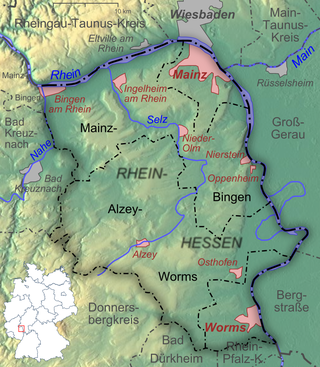
Rheinhessen is the largest of 13 German wine regions (Weinanbaugebiete) for quality wines with 26,758 hectares under cultivation in 2018. Named for the traditional region of Rhenish Hesse, it lies on the left bank of the Rhine between Worms and Bingen in the federal state of Rhineland-Palatinate. Despite its historic name it is currently no longer part of the federal-state of Hesse, this being the case since the end of World War II. There have been several unsuccessful attempts to legally reunite the former wine growing districts of Mainz on the Hessian side during the post-war area. Rheinhessen produces mostly white wine from a variety of grapes, particularly Riesling, Müller-Thurgau and Silvaner, and is best known as the home of Liebfraumilch, although some previously underrated Rieslings are also made, increasingly in a powerful dry style.

Ponticola kessleri, the bighead goby or Kessler's goby, is a species of goby native to Eurasia. The bighead goby is a Ponto-Caspian relict species. It inhabits the fresh and oligohaline waters, with mineralisation from 0-0.5‰ up to 1.5-3.0‰.

Dolycoris baccarum, the sloe bug or hairy shieldbug, is a species of shield bug in the family Pentatomidae.

Adelphocoris lineolatus, is commonly known as the Lucerne bug or the alfalfa plant bug, and belongs to the family Miridae. It is an agricultural pest causing vast amounts of damage to numerous crops, but primarily to alfalfa crops around the globe.

Boloria pales, the shepherd's fritillary, is a butterfly of the family Nymphalidae. It is found from the Cantabrian Mountains and the Pyrenees through the Alps and Apennine Mountains east to the Balkan, Carpathian Mountains, the Caucasus and central Asia up to western China.

Acraea anemosa, the broad-bordered acraea, is a butterfly of the family Nymphalidae which is native to southern Africa and coastal East Africa.

Graphium angolanus, the Angola white lady, is a species of butterfly in the family Papilionidae (swallowtails). It is found in Sub-Saharan Africa.

Tropidothorax leucopterus is a species of ground bugs belonging to the family Lygaeidae, subfamily Lygaeinae.

Lygaeus equestris, common name Black-and-Red-bug, is a species of ground bugs belonging to the family Lygaeidae, subfamily Lygaeinae.

Gonocerus acuteangulatus is a herbivorous species of true bug in the family Coreidae. It is commonly known as the box bug in the UK as it once only occurred in Box Hill in Surrey where it fed on box trees.
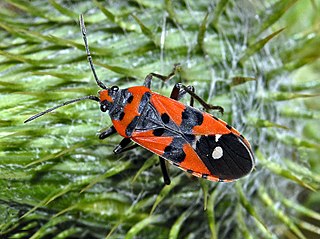
Lygaeus is a genus of seed bugs in the family Lygaeidae. There are more than 60 described species in Lygaeus.

Arocatus melanocephalus, the elm seed bug, is a true bug in the family Lygaeidae. The species was initially described by Johan Christian Fabricius in 1798, and Maximilian Spinola designated it to be the type species of the genus Arocatus in 1837. This bug is native to Europe but has been introduced to North America.
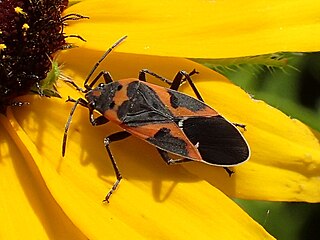
Lygaeus kalmii, known as the small milkweed bug or common milkweed bug, is a species of seed bug in the family Lygaeidae. It is found in Central and North America.
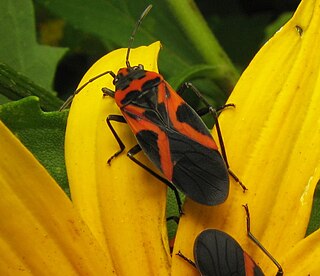
Lygaeus turcicus, the false milkweed bug, is a species of seed bug in the family Lygaeidae. It is found in Eastern North America.

Melanocoryphus is a genus of seed bugs in the family Lygaeidae. There are about eight described species in Melanocoryphus.




















